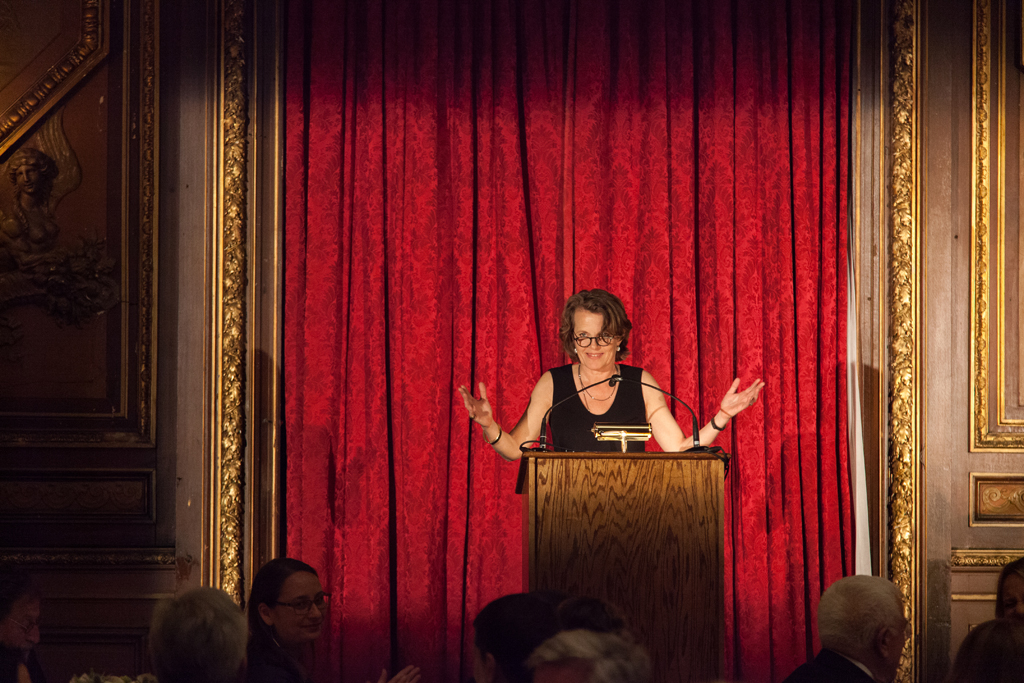Annabelle Selldorf on Richard Serra
An homage to the 2014 President's Medal honoree.
On May 6, 2014, The Architectural League awarded the President’s Medal, its highest honor, to artist Richard Serra. The remarks that follow were delivered by architect and League President Annabelle Selldorf at the dinner held in Serra’s honor.
I am pleased to be able to share with you some of my thoughts on Richard Serra’s work.
In a recent interview, Richard Serra told a story about seeing Charles Mingus. He said, “When I was in high school, I’d go to the Jazz Workshop in San Francisco, and one night Mingus was there playing a set. Because it was hot, the ceiling fan was on, but at one point the bartender shut the fan off. And Mingus—who weighed about 320 pounds and was 6′ 5″—jumps over the bar, lands on the other side, grabs the bartender, slams him against the wall, and says to him, ‘Turn that fan back on. That’s one of my instruments.’ And I’m sitting there—I’m 16, 17 years old, and I’m thinking, Holy Shit! You have to pay attention to everything all the time. A lot of what making art is about is paying attention.”
I must also have been 16 or 17, or even younger, when I first experienced Richard’s work. It would have been in Cologne, Germany. But by the late 1970s, I already lived in a world that Richard had influenced. It wasn’t necessarily a matter of recognizing a particular sculpture; it was a matter of recognizing that spaces are never neutral, that materials are never obvious, and that attention is the bridge that joins the person to culture.
For instance, there is one sculpture from 1971 which is called Three Cuts that never ceases to fascinate me. Imagine: a large thick and heavy plate of steel, supported on two beams, is cut three times and drops into an inevitable configuration. Once there, it is so still that it belies the act of cutting. Looking at it provokes the viewer to trace this act and evokes in me a visceral experience of the motion of cutting steel—paradoxical in itself. The plausibility of consequence and the sheer beauty of the interaction makes this an unforgettable sculpture in my mind.
We are gathered here to honor Richard Serra for many reasons—for his ongoing capacity to challenge, to change, and subvert space; for creating an art fundamentally in confrontation with movement and time; and for a material sensitivity that involves the viewer’s body as much as it does one’s entire perceptual apparatus. But, we are primarily here to acknowledge his revelation: that is, that you have to pay attention to everything all the time. If I were to proffer a shorthand definition for the site-specific, something inseparable from Richard’s practice, it is that. Of course there is weight. Of course there is volume and scale and mass, color, plane, gravity, and obviously place. But something called sculpture only coheres for Richard when each term is placed in relation to—and thought together with—all of the others. On that one night in San Francisco, without the heat and without the fan, Mingus’ double bass was simply incomplete.
We gather here to honor you, Richard, specifically as an architectural body. It is with unanimous enthusiasm that The Architectural League of New York confers this award to you, reflecting the great admiration the League and its members hold for you and the important place your work occupies in the imaginations of architects and the public alike. But to confer this award to you is, crucially, not to claim you as one of us, an architect. Indeed, I am compelled by your work—as is everyone here—specifically for its resistance to architecture, for the productive and generative strain of struggle that your work introduces equally to public and private spaces. I do not use the term resistance lightly, a term that too literally applied would take you for a rival or opponent. Instead, I see this resistance as a means of creating an opening, as an admission of precariousness and risk, a refusal to succumb to deadening sameness, a form of opposition that refuses a society’s passive assumptions. This is what your work does. It is why we gather to honor you this evening.
You have, in your own way, acknowledged this resistance. In an interview from 1983, when speaking of the relationship between architecture and sculpture, you said: “Every language has a structure about which nothing critical in that language can be said. To criticize a language, there must be a second language available dealing with the structure of the first but possessing a new structure.” 31 years later, we can acknowledge that our discourse has always been in relation to each other. I think about this looking at your recent project in Qatar, East-West/West-East, where four vertical plates of steel are aligned in a vast desert topography linking the visual planes, thus suggesting volume and seriality. So these are not planes, they are towers. And we might think that towers are the architect’s domain, but you have shown us that it is never that simple. Architecture and sculpture are in constant dialogue, interrupting and confronting, but always in proximity. We speak to and against each other and, in relation, create something that resounds and is the stronger for it.
Explore
Calvin Tsao on Ada Louise Huxtable
Official remarks by Calvin Tsao, League President 2006–2010, made during his presentation of the 2008 President's Medal.
Charles Eames
March 31, 1976 | Recordings from a dinner honoring Ray and Charles Eames at the National Arts Club in New York City | Reissued as part of Mid-Century Masters, a digital archive series.
Michael Bierut: How to make architecture out of paper
Graphic designer Bierut discusses the challenge of representing architectural ideas in two dimensions.

